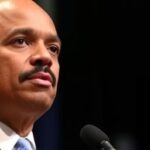In a striking contrast to optimistic retailer projections, Denver shoppers are tightening their belts this holiday season, planning to slash spending by 14% compared to last year. This local pullback mirrors a broader wave of consumer caution driven by escalating tariffs and economic jitters, even as national retail sales are tipped to shatter records with a whopping $1 trillion haul.
- Denver Families Slash Holiday Budgets in Face of Economic Pressures
- Tariff Threats Cast Long Shadow Over National Consumer Sentiment
- Retailers Defy Odds with Bold $1 Trillion Holiday Sales Forecast
- Local Strategies Emerge to Navigate Tariff-Driven Holiday Challenges
- Outlook Points to Resilient Recovery in Post-Holiday Retail Landscape
The divergence highlights a peculiar holiday dynamic: while Denver’s consumer sentiment sours under the shadow of potential price hikes from tariffs on imported goods, retailers remain bullish, banking on pent-up demand and strategic promotions to drive unprecedented retail sales. Local surveys reveal that families in the Mile High City are prioritizing essentials over extravagance, a trend that could reshape shopping patterns from Black Friday to New Year’s Eve.
Denver Families Slash Holiday Budgets in Face of Economic Pressures
Denver’s Holiday spending habits are undergoing a noticeable shift, with residents citing tariffs and inflation as key culprits behind their frugality. According to a recent poll by the Denver Chamber of Commerce, 62% of local consumers plan to spend less this year, averaging just $650 per household on gifts and festivities—down from $755 in 2023. This 14% dip in projected Holiday spending underscores a cautious consumer sentiment that’s rippling through neighborhoods from Capitol Hill to Cherry Creek.
“We’re seeing families rethink their wish lists,” said Elena Ramirez, a financial advisor with Denver-based Prosperity Partners. “Tariffs on everything from electronics to apparel are making shoppers wary of price spikes, so they’re opting for fewer, more meaningful purchases.” Ramirez’s observations align with data from the National Retail Federation (NRF), which notes that while national Holiday spending might climb, urban centers like Denver are bucking the trend due to higher living costs and trade policy uncertainties.
The impact is already visible in local malls and boutiques. At the Cherry Creek Shopping Center, foot traffic is steady but carts are lighter. Store owners report a surge in inquiries about price matching and layaway options, signaling a belt-tightening mentality. One shopper, Maria Gonzalez, shared her strategy while browsing holiday decor: “Last year, I splurged on gadgets for the kids, but with tariffs looming, I’m sticking to homemade gifts and sales. It’s about smart holiday spending now.”
This conservative approach isn’t isolated. A breakdown of spending categories shows apparel and toys taking the biggest hits, with 28% of Denver respondents planning to cut back on clothing purchases and 19% reducing toy budgets. Electronics, often hit hard by tariffs on Chinese imports, are seeing even steeper declines—projected at 22% less spending locally. Yet, essentials like groceries and home goods remain stable, suggesting consumers are redirecting funds rather than halting holiday spending entirely.
Tariff Threats Cast Long Shadow Over National Consumer Sentiment
Beyond Denver, tariffs are fueling a nationwide chill in consumer sentiment, amplifying fears of a holiday spending slowdown. Proposed duties on imports from China and Mexico—potentially reaching 60% on some goods—have economists warning of broader retail sales disruptions. The U.S. Chamber of Commerce estimates that these tariffs could add $2,600 annually to the average household’s expenses, eroding disposable income just as the holiday rush peaks.
“Consumer sentiment is at a fragile point,” noted Dr. Liam Harper, an economist at the University of Colorado Denver. “Tariffs don’t just raise prices; they create uncertainty that makes people hoard cash. In Denver, where the cost of living is already 15% above the national average, this hesitation is magnified.” Harper’s analysis draws from the Conference Board’s Consumer Confidence Index, which dipped to 98.7 in October, its lowest since mid-2023, with trade policies cited by 41% of respondents as a top concern.
Nationally, the ripple effects are clear. Retail sales data from the U.S. Census Bureau shows a modest 0.4% uptick in September, but projections for November and December temper enthusiasm amid tariff talks. Major retailers like Walmart and Target have preemptively raised prices on select items, prompting backlash from shoppers. In focus groups conducted by Nielsen, 55% of participants expressed reduced confidence in holiday spending due to economic uncertainty, with tariffs topping the list of worries alongside inflation and job market softness.
For Denver specifically, the city’s reliance on imported holiday staples—think festive lights from Asia or seasonal apparel from overseas—exposes it to acute risks. Local import data indicates that 35% of retail goods in Colorado pass through tariff-vulnerable supply chains. If duties materialize, experts predict a 5-7% hike in average gift prices, further dampening consumer sentiment and potentially shifting more shopping online to avoid local markups.
- Key Tariff Impacts: Electronics up 10-15%, apparel 8-12%, toys 7-10%.
- Consumer Response: 47% planning to shop sales earlier; 32% considering domestic alternatives.
- Denver-Specific: Higher exposure due to tourism-driven retail, with 20% of holiday sales tied to visitors.
Retailers Defy Odds with Bold $1 Trillion Holiday Sales Forecast
Despite the gloom in consumer sentiment, U.S. retailers are painting a rosy picture, forecasting record-breaking retail sales of over $1 trillion for the 2024 holiday season. The NRF’s projection marks a 3.8% increase from last year, driven by e-commerce growth, Black Friday deals, and a resilient job market. In Denver, chains like REI and local independents are doubling down on promotions to capture every dollar of holiday spending.
“We’re optimistic because consumers are value-savvy, not absent,” said Tom Erickson, vice president of sales at Denver’s flagship REI store. “Tariffs might pinch margins, but our focus on experiential gifting—like outdoor gear for Colorado winters—is resonating. We expect retail sales here to hold steady or even grow 2-3% locally.” Erickson’s confidence echoes industry-wide sentiment, with Amazon reporting early signs of robust online holiday spending, up 12% year-over-year.
The $1 trillion benchmark isn’t pie-in-the-sky; it’s backed by early indicators. October’s retail sales surged 2.1% in key categories like sporting goods and electronics, per Census data. Retailers are leveraging AI-driven personalization and flash sales to counter tariff-induced caution. For instance, Best Buy in Denver has launched a “Tariff-Proof Deals” campaign, offering price locks on imports to shield shoppers from hikes.
Yet, the optimism isn’t uniform. Smaller Denver retailers, comprising 40% of the local market, worry about squeezed profits. The Colorado Retail Council reports that independents anticipate only 1.5% growth in retail sales, versus 4% for big-box stores. Strategies include bundling products to boost average order values and partnering with local artisans to sidestep tariffs altogether. One such example is the Denver Flea’s holiday pop-up, where 75% of vendors source domestically, appealing to sentiment-driven shoppers seeking authentic, tariff-free gifts.
National forecasts also factor in seasonal boosts: Thanksgiving travel is up 5%, potentially spilling into retail sales, while Cyber Monday projections hit $12.4 billion. In Denver, events like the Christkindlmarket are expected to draw 300,000 visitors, injecting $50 million into local retail sales despite broader caution.
Local Strategies Emerge to Navigate Tariff-Driven Holiday Challenges
As tariffs loom, Denver’s retail landscape is adapting with innovative tactics to sustain holiday spending momentum. Community workshops on budget-friendly gifting are popping up at libraries and community centers, while apps like ShopLocalDenver promote tariff-light alternatives. Retailers are also investing in sustainability angles, marketing eco-friendly, U.S.-made products to align with evolving consumer sentiment.
“We’re turning challenges into opportunities,” explained Sarah Kline, owner of a boutique in LoDo. “By highlighting local makers, we’ve seen a 15% uptick in foot traffic from shoppers avoiding imported goods.” Kline’s approach reflects a broader trend: 68% of Denver consumers prefer supporting local businesses amid economic uncertainty, per a city survey.
Broader context includes federal responses. Lawmakers are debating tariff exemptions for holiday essentials, which could ease pressures if passed before December. Meanwhile, the Federal Reserve’s steady interest rates are providing some stability, though persistent inflation at 3.2% keeps consumer sentiment on edge.
Interviews with shoppers reveal a mix of resilience and restraint. At a focus group hosted by the Denver Post, participants like tech worker Jamal Ellis noted, “Tariffs make me think twice about that new phone, but I’ll still splurge on experiences—like a family ski trip.” This pivot toward services over goods could bolster non-retail holiday spending, indirectly supporting the economy.
- Adaptation Tactics: Price transparency campaigns to build trust.
- Digital Shifts: 40% increase in mobile shopping apps usage in Denver.
- Community Impact: Non-profits like Denver Rescue Mission see steady donation levels, as shoppers redirect savings to charity.
Outlook Points to Resilient Recovery in Post-Holiday Retail Landscape
Looking ahead, the holiday season’s tariff tensions could set the stage for a more adaptive retail environment in 2025. If duties are implemented, Denver’s retail sales might face a 2-4% correction in Q1, but experts predict a rebound fueled by tax refunds and spring promotions. Consumer sentiment surveys suggest that once uncertainty clears, pent-up holiday spending could unleash a surge in deferred purchases.
“The record $1 trillion forecast isn’t just hype—it’s a testament to retail’s agility,” Harper reiterated. For Denver, city officials are eyeing incentives like extended small business grants to weather any storm. Retailers, meanwhile, are preparing for omnichannel strategies, blending in-store events with seamless online experiences to capture every facet of holiday spending.
As Black Friday approaches, the juxtaposition of cautious consumers and confident retailers promises a holiday season of contrasts. Whether Denver’s 14% spending cut derails the national boom or merely tempers it remains to be seen, but one thing is clear: in the face of tariffs and uncertainty, innovation and resilience will define this year’s retail sales narrative.









